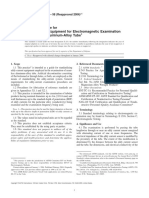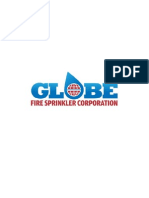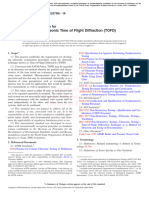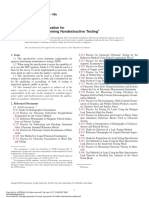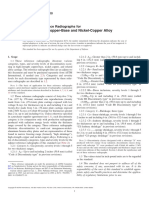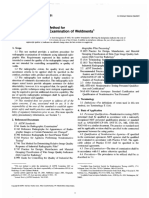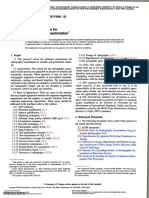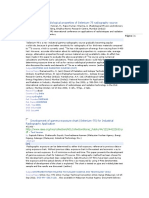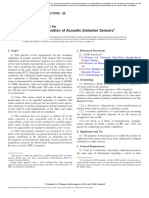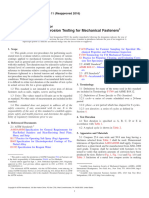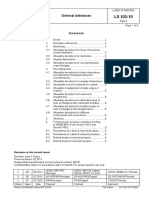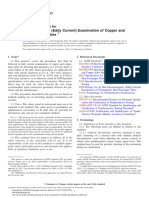ASTM E 1165 2020 - Measurement of Focal Spots of Industrial X-Ray Tubes by Pinhole Imaging
ASTM E 1165 2020 - Measurement of Focal Spots of Industrial X-Ray Tubes by Pinhole Imaging
Uploaded by
benderman1Copyright:
Available Formats
ASTM E 1165 2020 - Measurement of Focal Spots of Industrial X-Ray Tubes by Pinhole Imaging
ASTM E 1165 2020 - Measurement of Focal Spots of Industrial X-Ray Tubes by Pinhole Imaging
Uploaded by
benderman1Copyright
Available Formats
Share this document
Did you find this document useful?
Is this content inappropriate?
Copyright:
Available Formats
ASTM E 1165 2020 - Measurement of Focal Spots of Industrial X-Ray Tubes by Pinhole Imaging
ASTM E 1165 2020 - Measurement of Focal Spots of Industrial X-Ray Tubes by Pinhole Imaging
Uploaded by
benderman1Copyright:
Available Formats
This international standard was developed in accordance with internationally recognized principles on standardization established in the Decision on Principles
for the
Development of International Standards, Guides and Recommendations issued by the World Trade Organization Technical Barriers to Trade (TBT) Committee.
Designation: E1165 − 20
Standard Test Method for
Measurement of Focal Spots of Industrial X-Ray Tubes by
Pinhole Imaging1
This standard is issued under the fixed designation E1165; the number immediately following the designation indicates the year of
original adoption or, in the case of revision, the year of last revision. A number in parentheses indicates the year of last reapproval. A
superscript epsilon (´) indicates an editorial change since the last revision or reapproval.
1. Scope Development of International Standards, Guides and Recom-
1.1 The image quality and the resolution of X-ray images mendations issued by the World Trade Organization Technical
are especially sensitive to the characteristics of the focal spot. Barriers to Trade (TBT) Committee.
The imaging qualities of the focal spot are based on its two
2. Referenced Documents
dimensional intensity distribution as seen from the detector
plane. 2.1 ASTM Standards:2
E691 Practice for Conducting an Interlaboratory Study to
1.2 This test method provides instructions for determining
Determine the Precision of a Test Method
the effective size (dimensions) of standard and mini focal spots
E999 Guide for Controlling the Quality of Industrial Radio-
of industrial X-ray tubes for focal spot dimensions from
graphic Film Processing
100 µm up to several mm of X-ray sources up to 600 kV tube
E1000 Guide for Radioscopy
voltage. Smaller focal spots down to 50 µm could be evaluated
E1025 Practice for Design, Manufacture, and Material
with less precision. This determination is based on the mea-
Grouping Classification of Hole-Type Image Quality In-
surement of an image of a focal spot that has been radiographi-
dicators (IQI) Used for Radiography
cally recorded with a “pinhole” technique. An alternative
E1255 Practice for Radioscopy
method with a plaque hole IQI may be found in the Annex A,
E1742 Practice for Radiographic Examination
which covers the same focal spot sizes.
E1815 Test Method for Classification of Film Systems for
1.3 Smaller focal spots should be measured using Test Industrial Radiography
Method E2903 using the projection of an edge. E2002 Practice for Determining Total Image Unsharpness
1.4 This test method may also be used to determine the and Basic Spatial Resolution in Radiography and Radios-
change in focal spot size that may have occurred due to tube copy
age, tube overloading, and the like. This would entail the E2033 Practice for Radiographic Examination Using Com-
production of a focal spot radiograph (with the pinhole puted Radiography (Photostimulable Luminescence
method) and an evaluation of the resultant image for pitting, Method)
cracking, and the like. E2339 Practice for Digital Imaging and Communication in
Nondestructive Evaluation (DICONDE)
1.5 Units—Values stated in SI units are to be regarded as the E2698 Practice for Radiographic Examination Using Digital
standard. Detector Arrays
1.6 This standard does not purport to address all of the E2736 Guide for Digital Detector Array Radiography
safety concerns, if any, associated with its use. It is the E2903 Test Method for Measurement of the Effective Focal
responsibility of the user of this standard to establish appro- Spot Size of Mini and Micro Focus X-ray Tubes
priate safety, health, and environmental practices and deter- 2.2 European Standards:3
mine the applicability of regulatory limitations prior to use. EN 12543-2 Non-destructive testing—Characteristics of fo-
1.7 This international standard was developed in accor- cal spots in industrial X-ray systems for use in non-
dance with internationally recognized principles on standard- destructive testing—Part 2: Pinhole camera radiographic
ization established in the Decision on Principles for the method
1 2
This test method is under the jurisdiction of ASTM Committee E07 on For referenced ASTM standards, visit the ASTM website, www.astm.org, or
Nondestructive Testing and is the direct responsibility of Subcommittee E07.01 on contact ASTM Customer Service at service@astm.org. For Annual Book of ASTM
Radiology (X and Gamma) Method. Standards volume information, refer to the standard’s Document Summary page on
Current edition approved Dec. 1, 2020. Published February 2021. Originally the ASTM website.
3
approved in 1987. Last previous edition approved in 2017 as E1165 – 12(2017). Available from European Committee for Standardization (CEN), Avenue
DOI: 10.1520/E1165-20. Marnix 17, B-1000, Brussels, Belgium, http://www.cen.eu.
--``,,,,,`,,`,```````,`,`,,`,,,,-
Copyright © ASTM International, 100 Barr Harbor Drive, PO Box C700, West Conshohocken, PA 19428-2959. United States
Copyright ASTM International
Provided by IHS Markit under license with ASTM
1Licensee=Oceanearing Intl/5963382004, User=Barnard, Pieter Johannes
No reproduction or networking permitted without license from IHS Not for Resale, 02/01/2021 06:30:31 MST
E1165 − 20
EN 12543-5 Non-destructive testing—Characteristics of fo- with geometrical unsharpness, UG, focal spot size, φ, and
cal spots in industrial X-ray systems for use in non- magnification, v (see Guide E1000 for details of this equation).
destructive testing—Part 5: Measurement of the effective For a full description, see the WC-NDT 2012 paper cited in
focal spot size of mini and micro focus X-ray tubes Footnote 4.4
3. Terminology 4.2 Additionally, a simplified test method is described in
Annex A for users of X-ray tubes who may not intend to use a
3.1 Definitions of Terms Specific to This Standard: pinhole camera. This alternative method is based on the edge
3.1.1 actual focal spot, n—the X-ray producing area of the method according toTest Method E2903 using a plate hole IQI
target as viewed from a position perpendicular to the target as described in Practices E1025 or E1742 instead of a pinhole
surface (see Fig. 1). camera.
3.1.2 effective focal spot, n—the X-ray producing area of the
target as viewed by a detection device from a position 5. Significance and Use
perpendicular to the electron beam in the center of the resulting 5.1 One of the factors affecting the quality of radiologic
X-ray beam (see Fig. 1). images is the geometric unsharpness. The degree of geometric
3.1.3 effective size of focal spot, n—focal spot size measured unsharpness is dependent on the focal spot size of the radiation
according to this test method. source, the distance between the source and the object to be
radiographed, and the distance between the object to be
4. Summary of Test Method radiographed and the detector (imaging plate, Digital Detector
4.1 This test method is based on a projection image of the Array (DDA) or film). This test method allows the user to
focal spot using a pinhole camera. This image shows the determine the effective focal size of the X-ray source. This
intensity distribution of the focal spot. From this image the result may then be used to establish source to object and object
effective size of the focal spot is calculated. Using digital tools, to detector distances appropriate for maintaining the desired
an integration of the profile across the pinhole image trans- degree of geometric unsharpness or maximum magnification
forms the pinhole image into an edge response curve. The X- for a given radiographic imaging application, or both. Some
and Y-dimension of the edge unsharpness is used for calcula- ASTM standards require this value for calculation of a required
tion of the size of the focal spot. This method provides similar magnification, for example, Practices E1255, E2033, and
results as the method described in Test Method E2903 using an E2698.
edge target instead of a pinhole camera. The measured effective
spot sizes correspond to the geometrical image unsharpness 4
Klaus Bavendiek, Uwe Heike, Uwe Zscherpel, Uwe Ewert, and Adrian Riedo.
values at given magnifications as measured with the Practice “New measurement methods of focal spot size and shape of X-ray tubes in digital
E2002 duplex wire gauge in practical images using equation: radiological applications in comparison to current standards,” WC-NDT 2012,
Durban, South Africa, http://www.x-ray-forum.de/WCNDT_Paper346_WE_MR21
UG 5 φ~v 2 1! (1) _A_BavendiekEtAl.pdf.
FIG. 1 Actual/Effective Focal Spot
Copyright ASTM International 2Licensee=Oceanearing Intl/5963382004, User=Barnard, Pieter Johannes
--``,,,,,`,,`,```
Provided by IHS Markit under license with ASTM
No reproduction or networking permitted without license from IHS Not for Resale, 02/01/2021 06:30:31 MST
E1165 − 20
6. Apparatus 6.5.1 The detector basic spatial resolution, SRbdetector, shall
6.1 Pinhole Diaphragm—The pinhole diaphragm shall con- be taken from the vendor’s data sheet or determined with the
form to the design and material requirements of Table 1 and duplex wire IQI according to Practice E2002. The minimum
Fig. 2. projected length and width of the focal spot image should be
covered always by at least 20 detector pixels in digital images.
6.2 Camera—The pinhole camera assembly consists of the The maximum value for SRbdetector in Fig. 7, column 7 is the
pinhole diaphragm, the shielding material to which it is affixed, smaller value of both requirements in formula (2) and 20
and any mechanism that is used to hold the shield/diaphragm in detector pixels covering the focal spot.
position (jigs, fixtures, brackets, and the like). It is highly 6.5.2 The signal-to-noise ratio of the focal spot image (ratio
recommended to shield the beam between focal spot and of the maximum intensity value inside the focal spot and the
pinhole and between pinhole and detector to avoid a high level standard deviation of the background signal outside) should be
of scatter signal at the detector. A scatter protection of high at least 50. The maximum intensity inside the focal spot should
absorbing material within the camera is also recommended. be above 30 %, but lower than 90 % of the maximum linear
The accuracy of the pinhole system is especially sensitive to detector output value. The gray scale resolution of the detector
the relative distances between (and alignment of) the focal shall be in minimum 12 bit. The maximum background signal
spot, the pinhole, and the detector. Accordingly, a specially should be less than 15 % of the maximum intensity value of the
designed apparatus may be necessary in order to assure image; if this could not be achieved, a scatter protection
compliance with the requirements of this standard. Fig. 3 between pinhole and detector shall be applied (see Fig. 4).
provides an example of a special collimator that can be used to 6.5.3 Imaging plate systems (Computed Radiography, CR)
ensure conformance with 61° alignment tolerance. Fig. 4 or digital detector arrays (DDA) may be used as digital image
shows the collimator in the system and additionally the detectors following Practices E2033 or E2698. The pixel
shielding and scatter protection. values shall be linear to the dose.
6.3 Alignment and Position of the Pinhole Camera—The 6.5.4 If radiographic film is used as image detector, it shall
angle between the beam direction and the pinhole axis (see Fig. meet the requirements of Test Method E1815 film system class
5) shall be smaller than 61.5°. When deviating from Fig. 5, the I or Special and shall be packed in low absorption cassettes
direction of the beam shall be indicated. The incident face of using no screens. The film shall be exposed to a maximum
the pinhole diaphragm shall be placed at a distance, m, from the optical density between 1.5 and 2.5. The film shall be digitized
focal spot so that the variation of m over the extension of the with a maximum pixel of 50 µm or a smaller size, which fulfills
actual focal spot does not exceed 65 % in the beam direction. the requirements of Fig. 7. If the user has no digital equipment,
In no case shall this distance be less than 100 mm. the film may be evaluated visually; the procedure is shown in
6.4 Position of the Radiographic Image Detector—The 7.9. The film shall be processed in accordance with Guide
radiographic image detector (film, imaging plate or DDA) shall E999.
be placed normal to the beam direction at a distance, n, from 6.6 Image Processing Equipment—This apparatus is used to
the incident face of the pinhole diaphragm determined from the capture the images and to measure the intensity profile of the
applicable geometry according to Fig. 6(a), Fig. 6(b), and Fig. focal spot in the projected image. The image shall be a positive
7. image (more dose shows higher grey values) and linear
6.5 Radiographic Image Detector—Analogue or digital ra- proportional to the dose. The equipment shall be able:
diographic image detectors may be used, provided sensitivity, (1) To calibrate the pixel size with a precision of 2 µm or
dynamic range and detector unsharpness allow capturing of the 1 % of the pixel size,
full spatial size of the focal spot image without detector (2) To draw line profiles and average the line profiles over
saturation. The maximum allowed basic spatial resolution a preset area,
(SRbdetector) of the detector is determined from the pinhole (3) To integrate line profiles by the length of the line
diameter, P, and the factor n/m (see Fig. 6(a)). profile,
(4) To subtract the background using a linear interpolation
SR detector
b #
P
2 S
· 1 1
n
m D (2) (straight line) of both ends of the line profile using at least the
average of 10 % of the line profile as support on both ends, and
(5) To calculate the X- and Y-dimension of the focal spot in
the image with two threshold values of 16 % and 84 % of the
TABLE 1 Pinhole Diaphragm Design Requirements (Dimension)A integrated line profile and extrapolate the width to 100 % (see
Fig. 8).
NOTE 1—The pinhole diaphragm shall be made from one of the
following materials: (1) An alloy of 90 % gold and 10 % platinum, NOTE 1—A software that fulfills the requirements of 6.6 can be
(2) Tungsten, (3) Tungsten carbide, (4) Tungsten alloy, (5) Platinum and downloaded from http://www.zscherpel.info/ic/.
10 % Iridium Alloy, or (6) Tantalum.
6.6.1 When using CR technology or digitized film where
Diameter P [µm] Height H [µm]
outlier pixel may occur, a median 3×3 filter shall be available.
10 ± 5 20 ± 5
30 ± 5 75 ± 10 7. Procedure
100 ± 5 500 ± 10
A
See Fig. 2. 7.1 If possible, the geometry shown in Fig. 7 shall be used
for all exposures. If the machine geometry or accessibility
--``,,,,,`,,`,```````,`,`,,`,,,,-`
Copyright ASTM International
Provided by IHS Markit under license with ASTM
3Licensee=Oceanearing Intl/5963382004, User=Barnard, Pieter Johannes
No reproduction or networking permitted without license from IHS Not for Resale, 02/01/2021 06:30:31 MST
E1165 − 20
FIG. 2 Essential Dimensions of the Pinhole Diaphragm
limitations will not permit the use of the geometry in Fig. 7, use 7.5 Before evaluation, the image shall be inspected for
the maximum attainable FDD (in these instances adjust the spikes or outliers. These artifacts shall be removed using a
relative distances between focal spot, pinhole, and detector median or despeckle 3×3 filter. When a median filter is used,
accordingly to suit the image enlargement factors specified in the size of the focal spot in the image shall be more than 40
Fig. 7). The distance between the focal spot and the pinhole is pixels in both directions. For this case, column #8 of Fig. 7
based on the anticipated size of the focal spot being measured shows the requirements to SRbdetector.
and the desired degree of image enlargement (see Fig. 4). The
7.6 The images shall be stored with the nomenclature of 7.2
specified focal spot to pinhole distance (m) for the different
in 16 Bit lossless Image Format, for example, TIFF or Digital
--``,,,,,`,,`,```````,`,`,,`,,,,-`-`,,`,,`,`,,`---
focal spot size ranges is provided in Fig. 7. Position the pinhole
Imaging and Communication in Nondestructive Evaluation
such that it is within 61.5° of the central axis of the X-ray
(DICONDE); see Practice E2339.
beam (see 6.2).
7.2 Position the detector as illustrated in Fig. 4. When using 7.7 The pixel size in the image shall be calibrated by a
film as detector, the exposure identification appearing on the known object size in the image like a “ruler” or by measured
film (by radiographic imaging) should be X-ray machine geometry of the camera with the precision of 1 % of the
identity (make and serial number), organization making the anticipated focal spot size.
radiograph, energy (kV), tube current (mA) and date of 7.8 Focal Spot Measurement using Integrated Line Profiles
exposure. When the film is digitized or a digital detector is (ILP):
used, this information shall be stored within the image or file 7.8.1 A line profile shall be drawn in length or width
name. direction through the maximum intensity of the focal spot. The
7.3 Adjust the kilovoltage settings on the X-ray machine to line profile shall be accumulated perpendicular to the profile
75 % of the nominal tube voltage, but not more than 200 kV for direction over about 3 times the anticipated focal spot size (see
evaluation with film. For evaluation with a DDA or CR, the Fig. 8). The line profile should have a length of at least 3 times
maximum voltage is limited by the condition that the back- the anticipated focal spot size. The background shall be
ground intensity is lower than 15 % of the maximum intensity subtracted using a linear interpolation (straight line) of both
inside the focal spot. The X-ray tube current shall be the ends of the line profile, using at least the average of 10 % of the
maximum applicable tube current at the selected voltage. For line profile as support on both ends. When using the 10 µm
measurements with more than 200 kV when using CR or film, pinhole a penetration of the pinhole itself could occur creating
an optional copper prefilter may be used to prevent saturation a trapezoid-plateau in the image with gradients on both sides
of the imaging device. (see Fig. 9); this plateau should be removed using an iterative
background subtraction or the measurement shall be limited to
7.4 Expose the detector as given in 6.5. When using CR or
the flat plateau range as indicated in Fig. 9.
film, the maximum pixel value or density shall be controlled by
7.8.1.1 Now the line profile shall be integrated (accumu-
exposure time only. With a DDA the internal detector settings
lated). Then the points on the resulting curve at which the curve
(frame time or sensitivity, or both) shall be selected that the
has 16 % and 84 % of its max value shall be determined (see
conditions of 6.5 are met.
NOTE 2—The required SNR can be achieved with a DDA system by Klasens method of Guide E1000, and Fig. 16 in Guide E1000).
integration of frames with identical exposures in the computer. For details, The distance between these points is extrapolated to the
refer to Guide E2736. theoretical 0 % and 100 % values of the total focal spot
Copyright ASTM International
Provided by IHS Markit under license with ASTM
4Licensee=Oceanearing Intl/5963382004, User=Barnard, Pieter Johannes
No reproduction or networking permitted without license from IHS Not for Resale, 02/01/2021 06:30:31 MST
E1165 − 20
--``,,,,,`,,`,```````,`,`,,`,,,,-`-`,,`,,`,`,,`---
FIG. 3 Pinhole and Alignment Collimator Schematic
intensity by a multiplication with 1.47. The result is the size of 7.8.2 This measurement shall be done in two directions (see
the focal spot in the direction of the integrated line profile. Fig. 8 and Fig. 4):
NOTE 3—By using the values of 16 % and 84 %, instead of 0 % and 7.8.2.1 Direction X—Vertical to the electron beam direction
100 %, the determined size is 32 % too small. The factor 1.47 = (width).
100/(100–32) extrapolates this to 100 %.
Copyright ASTM International
Provided by IHS Markit under license with ASTM
5Licensee=Oceanearing Intl/5963382004, User=Barnard, Pieter Johannes
No reproduction or networking permitted without license from IHS Not for Resale, 02/01/2021 06:30:31 MST
E1165 − 20
FIG. 4 Exposure Set-Up Schematic and Focal Spot WIDTH (X) and LENGTH (Y) Specification
FIG. 5 Alignment of the Pinhole Diaphragm
7.8.2.2 Direction Y—Parallel to the electron beam direction 7.9 Focal Spot Evaluation for Users Without Digital Equip-
(length). ment:
7.8.2.3 If available, an automatic software system which 7.9.1 If radiographic film is used as an image detector and it
could perform the functionality of 7.8.1 and 7.8.2 within one cannot be digitized, it shall be evaluated visually using an
step may be used. illuminator with a uniform luminance of 2000 to 3000 cd/m2.
--``,,,,,`,,`,```````,`,`,,`,,,,-`-`,,`,,`,`,,`---
Copyright ASTM International
Provided by IHS Markit under license with ASTM
6Licensee=Oceanearing Intl/5963382004, User=Barnard, Pieter Johannes
No reproduction or networking permitted without license from IHS Not for Resale, 02/01/2021 06:30:31 MST
E1165 − 20
FIG. 6 Geometrical Conditions for Focal Spot Calculation With Example
NOTE 1—For a focal spot of Class FS7 (1000 µm) a pinhole with 30 µm diameter and a geometry with n/m = 3 is required due to Fig. 7. The projected
unsharpness, Ugp, of the pinhole is
U gp 5 P· ~ n ⁄ m 1 1 !
--``,,,,,`,,`,```````,`,`,,`,,,,-`-`,,`,,`,`,,`---
and in this case 120 µm. The required SRbdetector is 60 µm. The total projected unsharpness, UT,proj of both is calculated with
U T,proj 5 =U 2gp 1 ~ 2 · SR detector
b !2
which is 170 µm and has to be divided by the factor n/m to get the total unsharpness on the focal spot plane
U Im,φ 5 U T, proj ⁄ ~ n ⁄ m !
The influence of unsharpness, UIm, φ to the result of the focal spot measurement is 57 µm or 5.7 %.
The visual evaluation shall be carried out using an ×5 or ×10 magnifying glass, with a built-in reticle, with divisions of 0.1
Copyright ASTM International
Provided by IHS Markit under license with ASTM
7Licensee=Oceanearing Intl/5963382004, User=Barnard, Pieter Johannes
No reproduction or networking permitted without license from IHS Not for Resale, 02/01/2021 06:30:31 MST
E1165 − 20
NOTE 1—Yellow marks in the figure indicate changes from the former version of E1165.
NOTE 2—The figure uses mechanical elements with 15 cm each and with a modular set the different required factors n/m can be achieved. Other sizes
may be used but the image enlargement factors should be the same (see 7.1).
NOTE 3—The column for maximum SRbdetector in blue color shall be used in cases when a 3x3 Median filter is applied to remove outliers (see 7.5 for
details).
NOTE 4—The precision of this method decreases with smaller focal spots than class FS15 to a deviation of more than 10 %. For focal spots of class
FS16 and smaller, the edge method in the annexes or Test Method E2903 should be used.
NOTE 5—The 30 µm pinhole for the class FS10 creates a deviation of more than 10 %. If possible the 10 µm pinhole should be used for this class or
a detector with higher resolution.
NOTE 6—The right column with green characters shows as example the deviation due to the system unsharpness UIm,φ in the case a detector with a
SRbdetector of 25 µm is used for all classes (which is not unusual, because the detector is mainly fixed with the camera).
FIG. 7 Geometry, Pinhole Diameters, and Maximum SRbdetector for Focal Spot Pinhole Images
mm. The resulting focal spot shall be defined by the visible than one focal spot), the set-up and exposure parameters (for
extent of the blackened area, divided by the selected factor n/m. example, kilovoltage, milliamps, enlargement factor, SNR in
An example is shown in Fig. 10. the image, SRbdetector, and the like), date, name of organization,
and estimated beam time hours (if available).
8. Classification and Report
8.3 A print of the focal spot image may be added to the
8.1 The focal spot shall be classified according to its
report for information purposes only.
measured size. The preferred values of focal spot sizes and
dedicated classes are consistent with Practice E2002. The
measured values shall be rounded up to the nearest focal spot 9. Precision and Bias
size value in column 2 of Table 2. The values for width and 9.1 Statement of Precision:
length shall be taken separately and the maximum determines 9.1.1 There is no standard X-ray tube focal spot that can be
the focal spot class as shown in Table 2. An example of a dual measured and compared to the measurement results; therefore,
focal spot X-ray tube is given in Table 3. repeatability precision is defined as the comparison of repeated
8.2 A report documenting the focal spot size determination measurements of a given focal spot with different hardware and
should include the image name (see 7.6), machine model within three different laboratories. A round robin test report
number and serial number, the X-ray tube serial number, the according to Practice E691 was done with a 160 kV /HP11
focal spot(s) that was measured (some X-ray tubes have more tube, using CR technology with 5 different CR plates. The
--``,,,,,`,,`,```````,`,`,,`,,,,-`-`,,`,,`,`,,`---
Copyright ASTM International
Provided by IHS Markit under license with ASTM
8Licensee=Oceanearing Intl/5963382004, User=Barnard, Pieter Johannes
No reproduction or networking permitted without license from IHS Not for Resale, 02/01/2021 06:30:31 MST
E1165 − 20
(a) Image of a double line Focal Spot with the Location and Size of the Line Profile in Length Direction.
--``,,,,,`,,`,```````,`,`,,`,,,,-`-`,,`,,`,`,,`---
(b) Line Profile in the direction of the large arrow averaged over the dotted rectangle of Fig. 8a.
(c) Integrated Line Profile with Markers (blue) for 16 % and 84 % of the Profile Intensity, Markers (green) for 0 % and 100 %
Extrapolation and the Extrapolation Line (dotted black), corresponding to the Klasens method of Guide E1000.
(d) Pseudo 3D Image of the Focal Spot; the large arrow points in the direction of the Line Profile.
(e) Image of a double line Focal Spot with the Location and Size of the Line Profile in Width Direction.
(f) Integrated Line Profile with Markers (blue) for 16 % and 84 % of the Profile Intensity, Markers (green) for 0 % and 100 %
Extrapolation and the Extrapolation Line (dotted black) for the Width Direction.
FIG. 8 Example for the Measurement of Effective Focal Spot Length and Width with the Integrated Line Profile (ILP) Method
parameter were: 120 kV, 5.3 mA, 20 s exposure time, magni- 9.1.2 The mean value of the length of the focal spot is
fication 4.25, pinhole diameter 30 µm, scanner pixel size 25 µm 0.5553 mm and the width 0.5510 mm. The standard deviation
(5.9 µm effective pixel size), SNR = 78. is 0.004937 mm for the length and 0.00446 mm for the width
Copyright ASTM International
Provided by IHS Markit under license with ASTM
9Licensee=Oceanearing Intl/5963382004, User=Barnard, Pieter Johannes
No reproduction or networking permitted without license from IHS Not for Resale, 02/01/2021 06:30:31 MST
E1165 − 20
--``,,,,,`,,`,```````,`,`,,`,,,,-`-`,,`,,`,`,,`---
FIG. 8 Example for the Measurement of Effective Focal Spot Length and Width with the Integrated Line Profile (ILP) Method (continued)
(0.89 % and 0.81 %). In the Practice E691 evaluation, the therefore, a bias can not be measured. Due to the measurement
external and internal consistency values are within the critical procedure, there is no identified cause for a bias.
interval of 0.5 % significance level for focal spot length and 9.3 Conformance to the requirements specified with the film
width. procedure and visual evaluation of 7.9.1 will produce results
9.2 Statement on Bias: that are within the following tolerances:
9.2.1 There is no standard X-ray tube focal spot size that can 9.3.1 Technique—The technique requirements specified
be measured and compared to the measurement results; with the film procedure and visual evaluation of 7.9.1 will
Copyright ASTM International
Provided by IHS Markit under license with ASTM
10
Licensee=Oceanearing Intl/5963382004, User=Barnard, Pieter Johannes
No reproduction or networking permitted without license from IHS Not for Resale, 02/01/2021 06:30:31 MST
E1165 − 20
--``,,,,,`,,`,```````,`,`,,`,,,,-`-`,,`,,`,`,,`---
FIG. 9 Example of Trapezoid Plateau Effect When Using the 10 µm Pinhole With High Voltages (For Example, 200 kV) Caused by the
Penetration of the Pinhole; for Evaluation Only the Area Between the Blue Lines Shall be Used
produce a focal spot image whose size is 65 % of the actual Nominal Focal Spot Size, mm (in.) Measurement Tolerances
effective focal spot size. 0.3 to 1.2 (0.011 to 0.046) incl ±30 %
>1.2 to 2.5 (0.046 to 0.097) incl ±25 %
9.3.2 Measurement—The measurement requirements speci- >2.5 (0.097) ±20 %
fied with the film procedure and visual evaluation of 7.9.1 will
produce results that are within the tolerances:
Copyright ASTM International
Provided by IHS Markit under license with ASTM
11Licensee=Oceanearing Intl/5963382004, User=Barnard, Pieter Johannes
No reproduction or networking permitted without license from IHS Not for Resale, 02/01/2021 06:30:31 MST
E1165 − 20
FIG. 10 Example of Visual Film Evaluation with Magnifying Glass
10. Keywords
10.1 focal spot; pinhole camera; pinhole imaging; X-ray;
X-ray tube
--``,,,,,`,,`,```````,`,`,,`,,,,-`-`,,`,,`,`,,`---
Copyright ASTM International
Provided by IHS Markit under license with ASTM
12
Licensee=Oceanearing Intl/5963382004, User=Barnard, Pieter Johannes
No reproduction or networking permitted without license from IHS Not for Resale, 02/01/2021 06:30:31 MST
E1165 − 20
TABLE 2 Preferred Values of Focal Spot Sizes “φ” and
Dedicated Focal Spot Classes FS
Classes for standard and mini-focus focal spot sizes
FS 0 φ $ 4.0 mm
FS 1 4.0 mm > φ $ 3.2 mm
FS 2 3.2 mm > φ $ 2.5 mm
FS 3 2.5 mm > φ $ 2 mm
FS 4 2 mm > φ $ 1.6 mm
FS 5 1.6 mm > φ $ 1.27 mm
FS 6 1.27 mm > φ $ 1 mm
FS 7 1 mm > φ $ 0.8 mm
FS 8 0.8 mm > φ $ 0.63 mm
FS 9 0.63 mm > φ $ 0.5 mm
FS 10 0.5 mm > φ $ 0.4 mm
FS 11 0.4 mm > φ $ 0.32 mm
FS 12 0.32 mm > φ $ 0.25 mm
FS 13 0.25 mm > φ $ 0.2 mm
FS 14 0.2 mm > φ $ 0.16 mm
FS 15 0.16 mm > φ $ 0.13 mm
FS 16 0.127 mm > φ $ 0.1 mm
FS 17 0.1 mm > φ $ 0.08 mm
FS 18 0.08 mm > φ $ 0.06 mm
FS 19 0.063 mm > φ $ 0.05 mm
FS 20 0.05 mm > φ $ 0.04 mm
TABLE 3 Example of Classification Result
Company XXR 225-22
Measured Reported
Measured Reported Focal Spot
Length Length
Width (X) Width (X) Class
(Y) (Y)
Large Focus 2.32 mm × 1.63 mm 2.5 mm × 2.0 mm FS3
(3000W)
Small Focus 0.461 × 0.452 0.5 mm × 0.5 mm FS10
(640W) mm mm
ANNEX
(Mandatory Information)
A1. ALTERNATE FOCAL SPOT MEASUREMENT METHOD FOR END USERS
A1.1 Scope This method uses the edges of a large hole in a thin plate for
A1.1.1 User of X-Ray tubes may use alternatively an ASTM measurement of the focal spot size. The method is similar to
plate hole IQI for measurement of the focal spot size. This Test Method E2903. Here, instead of wires or spheres of high
method should provide equivalent values as the method de- absorbing material, hole type IQIs are used.
scribed above; the deviation to the ILP method is given in the A1.3 Apparatus
WC-NDT 2012 paper.4
A1.3.1 ASTM E1025 or E1742 IQI—The type of IQI should
A1.2 Background Information for Calculation of Unsharp- fit to the focal spot size (see A1.4.2 and Fig. A1.1). The
ness Due to Focal Spot Size material should be stainless steel or copper. The IQI shall be
placed on a shim block of stainless steel, brass, or copper and
A1.2.1 As shown in Guide E1000, two reasons for unsharp-
the material thickness of the shim block shall be two times the
ness in an X-ray image can be separated: Unsharpness from the
thickness of the IQI in use.
detector and unsharpness from the focal spot size and geo-
metrical magnification. If the other parameters are known the A1.3.2 Radiographic Image Detector—A radiographic im-
focal spot size, φ can be calculated from the measured age detector which is used in the X-ray system shall also be
unsharpness in the image UIm, magnification v, and SRbdetector used for image capture.
as measured basic spatial resolution of the detector: A1.3.3 Image Processing Equipment—This apparatus is
ϕ5
v
v21
ΠS2
2
U lm 2
2.0
v
· SR detector
b D 2
(A1.1)
used to capture the images. The grayscale of the image shall be
linear proportional to the dose. The equipment shall be able:
(1) To calibrate the pixel size with a precision of 1 µm or
For a full description, see the WC-NDT 2012 paper.4 1/100 of the anticipated focal spot size—whatever is larger
--``,,,,,`,,`,```````,`,`,,`,,,,-`-`,,`,,`,`,,`---
Copyright ASTM International
Provided by IHS Markit under license with ASTM
13
Licensee=Oceanearing Intl/5963382004, User=Barnard, Pieter Johannes
No reproduction or networking permitted without license from IHS Not for Resale, 02/01/2021 06:30:31 MST
E1165 − 20
FIG. A1.1 ASTM IQIs for Measurement of Spot Size by Edge Evaluation
(2) To draw averaged line profiles with a width which is The angle of penetration of the IQI shall be 90° (61.5°).
adjustable It shall be assured that the size inside the hole profile is in
(3) To measure distances in the line profile with the minimum four times larger than the size of the unsharpness of
precision of 1/50 of the anticipated focal spot size (see Fig. the edge profile. Additionally, the diameter of the hole in the
A1.2). image shall be more than 100 pixels.
(4) Optional: a software routine shall be available to A1.4.3 An image shall be captured. The SNR shall be larger
measure the edge unsharpness automatically using the hole than 100 in the image on the IQI beside the 4T hole.
size, the pixel size, and SRbdetector as input value (see Fig. A1.4.3.1 If the SNR is larger than 300, a digital magnifica-
A1.3). tion of factor two with a bilinear (or higher degree) interpola-
A1.4 Procedure tion between the pixel may be used.
A1.4.1 The evaluation shall be done in the X-ray system A1.4.4 The pixel size in the image shall be calibrated by a
where the X-ray tube is integrated. known object size in the image, for example, the IQI dimension
of the plate or of the 4T hole. The precision of calibration shall
A1.4.2 The IQI should be placed on a Brass, Copper or be 1/100 of the hole diameter.
Inconel shim block with two times the thickness (t) of the
thickness of the IQI (T): A1.5 Evaluation
t 5 2·T (A1.2) A1.5.1 Manual Evaluation Using a Line Profile:
The IQI hole diameter shall fit to the anticipated focal spot A1.5.1.1 A line profile shall be drawn in horizontal direction
size. The diameter of the hole shall be smaller than fifteen and it shall be averaged over in minimum 5 pixel or the width
times the anticipated focal spot size and larger than two times of 1/20 of the hole diameter.
the focal spot size. A1.5.1.2 A marker shall be set at 50 % (62 %) of the signal
The energy shall be 75 % (65 %) of maximum energy of the inside the hole; see Fig. A1.2, location A. A second marker
tube but not more than the maximum voltage used in all shall be placed at 84 % (6 2 %) of the signal inside the hole;
applications. The tube current shall be the maximum which is see Fig. A1.2, location B. The horizontal distance between the
possible at that voltage. The beam should be collimated and markers (E to F) shall be noted in pixel or real units. A third
exposure field size at IQI surface should be limited to cover marker shall be placed at the 50% point on the opposite side of
IQI, only. The exposure time (CR) or the internal integration the profile; see Fig. A1.2, location C. A fourth marker shall be
time and sensitivity (DDA and Radioscopy) shall be adjusted placed at the 84% point; see Fig. A1.2, location D. The
that the signal in the hole of the IQI is in the range of 30 % to horizontal spacing between these markers (G to H) shall be
90 % of the maximum signal possible. The area of the IQI calculated as for E to F. The values of EF and GH shall be
beside the hole shall have a signal of in minimum 10 % of the added.
maximum signal possible. If these conditions cannot be A1.5.1.3 The result shall be multiplied by a factor of 1.4.5
achieved with the setup, a thinner or thicker IQI shall be used This extrapolates the unsharpness calculation of UIm to the full
together with an adapted shim block. The 2T hole or the 4T height of the profile and accounts for the fact that the hole
hole should be used. A minimum magnification of 2 shall be edges are not parallel with the ray paths. This will be the value
used. of the image unsharpness, UIm, to be used in Eq A1.1.
Furthermore, the minimum magnification, vmin, shall be
selected in relation to the effective pixel size SRbdetector
determined with the duplex wire IQI according to Practice 5
To compensate the edge penetration which leads to about 5 % higher values, the
E2002 and anticipated focal spot size (afs): extrapolation factor is 1.4 instead of 1.47. The bias is caused by the fact that the
edges are not in the center of the beam and therefore the X-rays do not penetrate it
v min 5 5·SR detector
b /afs (A1.3) at a 90 degree angle.
--``,,,,,`,,`,```````,`,`,,`,,,,-`-`,,`,,`,`,,`---
Copyright ASTM International
Provided by IHS Markit under license with ASTM
14
Licensee=Oceanearing Intl/5963382004, User=Barnard, Pieter Johannes
No reproduction or networking permitted without license from IHS Not for Resale, 02/01/2021 06:30:31 MST
E1165 − 20
--``,,,,,`,,`,```````,`,`,,`,,,,-`-`,,`,,`,`,,`---
NOTE 1—Hint: The measurement is performed in analogy to the method of measurement of micro focus spot sizes of Test Method E2903.
FIG. A1.2 Measurement of the Focal Spot Size from the Horizontal Edge Profile with Thresholds of 50 % to 84 % on Both Sides of the
Line Profile; Correction with Detector Unsharpness and the Extrapolation Factor of 1.4 Shall be Applied for Final Calculation of the Ef-
fective Focal Spot Size; The Effective Focal Spot Size of the Example Shown in Fig. A1.2 is 550 µm in Horizontal Direction
If the values of EF and GH are taken in pixel, the total A1.5.1.4 The resulting unsharpness still contains the un-
unsharpness shall be multiplied with the pixel pitch and sharpness due to the detector. The effective focal spot size,φ,
divided by the geometric magnification to express the unsharp- shall be calculated using Eq A1.1 in A1.2 with UIm of A1.4.
ness in the dimensions of the indication. A1.5.1.5 Repeat the evaluation in the vertical direction in
See Eq A1.4 (if EF and GH in real units [µm]) and Eq A1.5 the same manner.
(if EF and GH in Pixel) for both cases:
A1.5.1.6 The corrected values of the effective focal spot
U Im 5 ~ E F 1 G H ! ·1.4 (A1.4) size shall be assigned to the X or Y direction of the X-ray tube
~ E F 1 G H ! ·pixel pitch (depending on the orientation of the tube in the X-ray system;
U Im 5 ·1.4 (A1.5)
v see Fig. 4).
Copyright ASTM International
Provided by IHS Markit under license with ASTM
15
Licensee=Oceanearing Intl/5963382004, User=Barnard, Pieter Johannes
No reproduction or networking permitted without license from IHS Not for Resale, 02/01/2021 06:30:31 MST
E1165 − 20
--``,,,,,`,,`,```````,`,`,,`,,,,-`-`,,`,,`,`,,`---
FIG. A1.3 Measurement of the Spot Size of the Four Edges with Threshold from 50 % to 84 % and Extrapolation with Factor 1.4 with Au-
tomatic Calculation of the Effective Focal Spot Size in X and Y Direction
A1.5.2 Automatic Evaluation Using a Software Function: A A1.7.1.1 A test report according to Practice E691 was
Region of Interest (ROI) shall be drawn around the hole with repeated with the tube of the reliability test of 9.1 using
about double the diameter of the hole. The calibration of the different positions of the IQI. The automatic evaluation with
pixel size shall be done by entering the hole size in real units, the software function was used. The parameters were 120 kV,
the pixel size and the detector resolution SRbdetector. The 5.3 mA, Magnification 5.0, IQI hole size 3.05 mm (2T hole),
software shall calculate the calibration value by using the 50 % pixel size 200 µm, SRbdetector = 230 µm, SNR = 420.
signal level threshold in both horizontal and vertical direction. The mean value of the length of the focal spot due to this
Then the software shall evaluate the unsharpness on the four
method is 0.5406 mm and the width 0.5591 mm. The standard
edges in vertical and horizontal direction using 50 % and 84 %
deviation is 0.017036 mm for the length and 0.008012 mm for
thresholds. The values of the two edges for vertical unsharp-
the width (3.15 % and 1.43 %). In the Practice E691
ness shall be summed and the same shall be done for the
horizontal direction. The results shall be extrapolated to 100 % evaluation, the external and internal consistency values are
with the extrapolation factor of 1.45 and then corrected for the within the critical interval of 0.5 % significance level for focal
detector unsharpness using the correction from (Eq A1.1) from spot length and width.
A1.2 within the software. A1.7.1.2 Using the manual evaluation with the line profile
The results shall be recorded; it may also be displayed in the the precision also depends on the exact position of the four
image (see Fig. A1.3) or written in a result file. markers in vertical and horizontal direction.
The resulting values shall be assigned to the X or Y direction
A1.7.2 Statement on Bias:
of the X-ray tube (depending of the orientation of the tube in
the X-ray system; see Fig. 4 for the assignment). A1.7.2.1 As reference for the focal spot size, the value of
the ILP method was taken (see 9.1). The deviation of the user
A1.6 Report method to the reference values were –2.64 % for the length and
A1.6.1 If one value is needed as effective focal spot size 1.47 % for the width.
only, the maximum of the horizontal or vertical value shall be Bias of the user method is produced by edge penetration of
taken as the result of the test. the IQI which may lead to larger values and the position of the
IQI in length direction due to the steep angle of the target (see
A1.7 Precision and Bias
Fig. 1).
A1.7.1 Statement of Precision:
Copyright ASTM International
Provided by IHS Markit under license with ASTM
16
Licensee=Oceanearing Intl/5963382004, User=Barnard, Pieter Johannes
No reproduction or networking permitted without license from IHS Not for Resale, 02/01/2021 06:30:31 MST
E1165 − 20
ASTM International takes no position respecting the validity of any patent rights asserted in connection with any item mentioned
in this standard. Users of this standard are expressly advised that determination of the validity of any such patent rights, and the risk
of infringement of such rights, are entirely their own responsibility.
This standard is subject to revision at any time by the responsible technical committee and must be reviewed every five years and
if not revised, either reapproved or withdrawn. Your comments are invited either for revision of this standard or for additional standards
and should be addressed to ASTM International Headquarters. Your comments will receive careful consideration at a meeting of the
responsible technical committee, which you may attend. If you feel that your comments have not received a fair hearing you should
make your views known to the ASTM Committee on Standards, at the address shown below.
This standard is copyrighted by ASTM International, 100 Barr Harbor Drive, PO Box C700, West Conshohocken, PA 19428-2959,
United States. Individual reprints (single or multiple copies) of this standard may be obtained by contacting ASTM at the above
address or at 610-832-9585 (phone), 610-832-9555 (fax), or service@astm.org (e-mail); or through the ASTM website
(www.astm.org). Permission rights to photocopy the standard may also be secured from the Copyright Clearance Center, 222
Rosewood Drive, Danvers, MA 01923, Tel: (978) 646-2600; http://www.copyright.com/
--``,,,,,`,,`,```````,`,`,,`,,,,-`-`,,`,,`,`,,`---
Copyright ASTM International
Provided by IHS Markit under license with ASTM
17
Licensee=Oceanearing Intl/5963382004, User=Barnard, Pieter Johannes
No reproduction or networking permitted without license from IHS Not for Resale, 02/01/2021 06:30:31 MST
You might also like
- 15614-5 EN ISO (E) (Welding Procedure)Document26 pages15614-5 EN ISO (E) (Welding Procedure)benderman1100% (3)
- Yaw Spring Pack Loose Bolts Repair WorkDocument2 pagesYaw Spring Pack Loose Bolts Repair WorkJuanNo ratings yet
- Vertical Transportation SystemsDocument33 pagesVertical Transportation SystemsJelitta ElizabathNo ratings yet
- E1742-00 Radiographic ExaminationDocument14 pagesE1742-00 Radiographic Examinationphanthanhhung100% (1)
- E1817 PDFDocument3 pagesE1817 PDFalfonso_comimsaNo ratings yet
- E 215 - 98 R04 - Rtixnq - PDFDocument7 pagesE 215 - 98 R04 - Rtixnq - PDFLeón SuárezNo ratings yet
- Heat Conduction Lab ReportDocument3 pagesHeat Conduction Lab ReportJohnConor96% (24)
- Globe Sprinkler CompanyDocument20 pagesGlobe Sprinkler CompanyWinard WantogNo ratings yet
- Astm e 2446Document9 pagesAstm e 2446김경은No ratings yet
- E1411-95 Radioscopic System QualificationDocument12 pagesE1411-95 Radioscopic System QualificationsanthakumarNo ratings yet
- Standard Test Method For Radioscopic Examination of WeldmentsDocument5 pagesStandard Test Method For Radioscopic Examination of WeldmentsWagner Renato AraújoNo ratings yet
- Astm E1030Document11 pagesAstm E1030steflinoNo ratings yet
- Astm e 1114Document5 pagesAstm e 1114KEN KNo ratings yet
- Astm E94 E94m 22Document11 pagesAstm E94 E94m 22minatamayo97No ratings yet
- E592 PDFDocument5 pagesE592 PDFALFONSO_08No ratings yet
- Astm E2373 E2373m 19Document6 pagesAstm E2373 E2373m 19Mohamed AboelkhierNo ratings yet
- E543 - Ensayos No DestructivosDocument11 pagesE543 - Ensayos No Destructivosmanoloxz8No ratings yet
- Eddy Current Examination of Steel Tubular Products Using Magnetic SaturationDocument2 pagesEddy Current Examination of Steel Tubular Products Using Magnetic SaturationChenjie ZhuNo ratings yet
- High-Strength Copper-Base and Nickel-Copper Alloy Castings: Standard Reference Radiographs ForDocument5 pagesHigh-Strength Copper-Base and Nickel-Copper Alloy Castings: Standard Reference Radiographs ForSarita SharmaNo ratings yet
- ANSI N323A-1997 American National Standard Radiation Protection Instrumentation Test and Calibration, Portable Survey InstrumentsDocument23 pagesANSI N323A-1997 American National Standard Radiation Protection Instrumentation Test and Calibration, Portable Survey Instrumentsayman m.waleedNo ratings yet
- Appendix Vi Rounded IndicationsDocument10 pagesAppendix Vi Rounded IndicationsEmilce Bogado MartinezNo ratings yet
- Digital Profile Radiography - Practical Uses and LimitationsDocument24 pagesDigital Profile Radiography - Practical Uses and LimitationsMohan RajNo ratings yet
- Astm E-1032Document5 pagesAstm E-1032Mustafa Ersin EkremNo ratings yet
- Measurement of Prep Ene Trant EtchDocument6 pagesMeasurement of Prep Ene Trant EtchPDDELUCANo ratings yet
- Se 1025Document7 pagesSe 1025Roohian AliNo ratings yet
- E2297-04 (2010) Standard Guide For Use of UV-A and Visible Light Sources and Meters Used in The Liquid Penetrant and Magnetic Particle Methods PDFDocument5 pagesE2297-04 (2010) Standard Guide For Use of UV-A and Visible Light Sources and Meters Used in The Liquid Penetrant and Magnetic Particle Methods PDFAnonymous PEHDuKRjoNo ratings yet
- E1936-97 Evaluating Digitization SystemsDocument4 pagesE1936-97 Evaluating Digitization SystemsNDT Div, MedequipNo ratings yet
- 6082 t6 Aluminium Round BarDocument12 pages6082 t6 Aluminium Round Barben norwoodNo ratings yet
- Radiographic Examination: Standard Practice ForDocument17 pagesRadiographic Examination: Standard Practice ForsaulNo ratings yet
- Ultrasonic Angle-Beam Examination of Steel Plates: Standard Specification ForDocument3 pagesUltrasonic Angle-Beam Examination of Steel Plates: Standard Specification ForSama UmateNo ratings yet
- Selenium 75, Ir 192 and X-RaysDocument5 pagesSelenium 75, Ir 192 and X-RaysLei LaniNo ratings yet
- E3022-15 Standard Practice For MeasuremPPTDocument8 pagesE3022-15 Standard Practice For MeasuremPPTManuel Andres Mantilla DuranNo ratings yet
- E1219-10 Standard Practice For Fluorescent Liquid Penetrant Testing Using The Solvent - Removable Process PDFDocument6 pagesE1219-10 Standard Practice For Fluorescent Liquid Penetrant Testing Using The Solvent - Removable Process PDFManuel Andres Mantilla DuranNo ratings yet
- E390-15 Radiografías de Referencia Estándar para Soldaduras Por Fusión de Acero1Document4 pagesE390-15 Radiografías de Referencia Estándar para Soldaduras Por Fusión de Acero1fredy lopezNo ratings yet
- 46 CFR 56Document71 pages46 CFR 56pkitchen25No ratings yet
- Astm E1001Document10 pagesAstm E1001Jon DownNo ratings yet
- 6082 T6 Aluminum Plate SuppliersDocument9 pages6082 T6 Aluminum Plate Supplierssanghvi overseas incNo ratings yet
- Selenium 75Document5 pagesSelenium 75jimmy david espinoza mejiaNo ratings yet
- E 2261 - 03 - Rtiynje - PDFDocument13 pagesE 2261 - 03 - Rtiynje - PDFrockneeNo ratings yet
- Standard Practice For Secondary Calibration of Acoustic Emission SensorsDocument8 pagesStandard Practice For Secondary Calibration of Acoustic Emission SensorsArpan NandyNo ratings yet
- Microwave Scanning Technology For Mate-Rial Testing: ECNDT 2006 - Th.4.2.2Document8 pagesMicrowave Scanning Technology For Mate-Rial Testing: ECNDT 2006 - Th.4.2.2TinhVoNo ratings yet
- BS en 9934-3Document21 pagesBS en 9934-3The Normal HeartNo ratings yet
- F2832-11 (Reapproved 2016)Document5 pagesF2832-11 (Reapproved 2016)Mohammed EldakhakhnyNo ratings yet
- Ultrasonic Inspection Techniques Possibilities ForDocument4 pagesUltrasonic Inspection Techniques Possibilities ForAllwynNo ratings yet
- Electromagnetic (Eddy Current) Examination of Copper and Copper-Alloy TubesDocument6 pagesElectromagnetic (Eddy Current) Examination of Copper and Copper-Alloy Tubesedapo79No ratings yet
- E703-98 EC Sorting of NonFerrous PDFDocument5 pagesE703-98 EC Sorting of NonFerrous PDFTerfaia NadjatNo ratings yet
- ASTM E2884 13e1Document7 pagesASTM E2884 13e1tkNo ratings yet
- Asme Sec V A-2-2004 PDFDocument39 pagesAsme Sec V A-2-2004 PDFjaire esparzaNo ratings yet
- Gen Neral Tole Rances: Content TsDocument9 pagesGen Neral Tole Rances: Content Tsrony16novNo ratings yet
- E192-13 Standard Reference Radiographs of Investment Steel Castings For Aerospace ApplicationsDocument3 pagesE192-13 Standard Reference Radiographs of Investment Steel Castings For Aerospace ApplicationsLorena Jimenez100% (1)
- Ultrasonic Angle-Beam Contact Testing: Standard Practice ForDocument9 pagesUltrasonic Angle-Beam Contact Testing: Standard Practice ForNubia BarreraNo ratings yet
- ASTM For Radiographic TestingDocument1 pageASTM For Radiographic TestingMICHAELNo ratings yet
- Is 9902 2004 PDFDocument11 pagesIs 9902 2004 PDFAgniva DuttaNo ratings yet
- ToFD TransducersDocument6 pagesToFD TransducersscribdmustaphaNo ratings yet
- Astm e 1118Document12 pagesAstm e 1118KEN K100% (1)
- E243 13 PDFDocument6 pagesE243 13 PDFDaniel Mauricio Prieto ValderramaNo ratings yet
- Scanner Cobra en 201507Document2 pagesScanner Cobra en 201507Shahbaz KhanNo ratings yet
- Norma Astm G76 18Document6 pagesNorma Astm G76 18Juancho CastroNo ratings yet
- Mil STD 1949Document36 pagesMil STD 1949ManivannanMudhaliarNo ratings yet
- Astm E2192-13 (2018)Document23 pagesAstm E2192-13 (2018)AnaNo ratings yet
- High-Strength Copper-Base and Nickel-Copper Alloy Castings: Standard Reference Radiographs ForDocument5 pagesHigh-Strength Copper-Base and Nickel-Copper Alloy Castings: Standard Reference Radiographs ForSarita SharmaNo ratings yet
- Mil STD 792 ReveDocument12 pagesMil STD 792 ReveMarcelo Rueda MartínezNo ratings yet
- ASTM E 1114 2020 - Determining The Size of Iridium-192, Cobalt-60, and Selenium-75 Industrial Radiographic SourcesDocument8 pagesASTM E 1114 2020 - Determining The Size of Iridium-192, Cobalt-60, and Selenium-75 Industrial Radiographic Sourcesbenderman1No ratings yet
- BS 6956-1-1988 - (2020-12-15 - 12-40-01 PM)Document10 pagesBS 6956-1-1988 - (2020-12-15 - 12-40-01 PM)benderman1No ratings yet
- BS 7984-3-2020 - (2021-05-18 - 08-00-55 Am)Document22 pagesBS 7984-3-2020 - (2021-05-18 - 08-00-55 Am)benderman1No ratings yet
- BS 7591-4-1993 - (2020-12-09 - 03-47-57 PM)Document14 pagesBS 7591-4-1993 - (2020-12-09 - 03-47-57 PM)benderman1No ratings yet
- BS 7591-2-1992 - (2020-12-09 - 03-48-36 PM)Document22 pagesBS 7591-2-1992 - (2020-12-09 - 03-48-36 PM)benderman1No ratings yet
- PDF LogbookDocument1 pagePDF Logbookbenderman1No ratings yet
- Measurement Report: 5Mhz 64elts Linear Phased Array Model: 5L64-0.5×10-L70-U-110-5.0-P1 SN: Kl1733Mbd961Document7 pagesMeasurement Report: 5Mhz 64elts Linear Phased Array Model: 5L64-0.5×10-L70-U-110-5.0-P1 SN: Kl1733Mbd961benderman1No ratings yet
- UntitledDocument1 pageUntitledbenderman1No ratings yet
- Formula Sheet & Velocity ChartDocument2 pagesFormula Sheet & Velocity Chartbenderman1No ratings yet
- Discontinuity ClassificationsDocument7 pagesDiscontinuity Classificationsbenderman1No ratings yet
- Eddy Current Testing - Formulae Sheet Exam FormatDocument1 pageEddy Current Testing - Formulae Sheet Exam Formatbenderman1No ratings yet
- Ultrasonic Testing Level I - Material Data Sheet - Velocity ChartDocument1 pageUltrasonic Testing Level I - Material Data Sheet - Velocity Chartbenderman1No ratings yet
- Ultrasonic Testing Level Ii - Formula SheetDocument2 pagesUltrasonic Testing Level Ii - Formula Sheetbenderman1No ratings yet
- Asme B31.3, Table RTDocument3 pagesAsme B31.3, Table RTbenderman1No ratings yet
- Ultrasonic Testing Level Ii - GuidelinesDocument1 pageUltrasonic Testing Level Ii - Guidelinesbenderman1No ratings yet
- Asme Viii, Div.1, App.4 - RTDocument8 pagesAsme Viii, Div.1, App.4 - RTbenderman1No ratings yet
- Asme b31.3, Par. 344.3 MT and Par. 344.4 PTDocument1 pageAsme b31.3, Par. 344.3 MT and Par. 344.4 PTbenderman1No ratings yet
- 1435-1997-A2 EN (E) (Radiographie)Document4 pages1435-1997-A2 EN (E) (Radiographie)benderman1No ratings yet
- Asme Viii, Div.1, App.8 - PTDocument2 pagesAsme Viii, Div.1, App.8 - PTbenderman1No ratings yet
- EN ISO (E) (Welding Procedure)Document9 pagesEN ISO (E) (Welding Procedure)benderman1No ratings yet
- Aws B2.1.006Document11 pagesAws B2.1.006benderman1No ratings yet
- Study of BUET Power Plant and Sub-Stations: EEE 306 Experiment 5Document4 pagesStudy of BUET Power Plant and Sub-Stations: EEE 306 Experiment 5সামিন জাওয়াদ100% (1)
- CNC Programming Enhanced Learning System Mill PDFDocument146 pagesCNC Programming Enhanced Learning System Mill PDFYOZINo ratings yet
- SchoolNet Goal G-MGDocument63 pagesSchoolNet Goal G-MGTamera FieldsNo ratings yet
- Minidso La104 Logic AnalyzerDocument4 pagesMinidso La104 Logic AnalyzerIvona ŠupićNo ratings yet
- Sine-Triangle Vs Space Vector Modulation For 3L-VSIDocument7 pagesSine-Triangle Vs Space Vector Modulation For 3L-VSIharkoneneNo ratings yet
- Physics: Application of Integration-1: T T T BV V BVT BVTDocument4 pagesPhysics: Application of Integration-1: T T T BV V BVT BVTShibhaditya DohareNo ratings yet
- Ch. 30 - Maxwell's Equations and Electromagnetic WavesDocument8 pagesCh. 30 - Maxwell's Equations and Electromagnetic WavesAbdallah IslaihNo ratings yet
- Name: - Program & Year: - Section: - Student No.: - Seat No.: - Signature: - Date: - Problem Set PS3.2 ScoreDocument2 pagesName: - Program & Year: - Section: - Student No.: - Seat No.: - Signature: - Date: - Problem Set PS3.2 ScoreJustin ViberNo ratings yet
- Permanent Magnet DC MotorDocument4 pagesPermanent Magnet DC MotorPulkit ChaudhariNo ratings yet
- GIET University Department of Basic Scence and Humanities Engineering ChemistryDocument3 pagesGIET University Department of Basic Scence and Humanities Engineering ChemistryARI ESNo ratings yet
- Automated Carton Conveyor System: Automation Project: PLC Based Coal Crushing and ConveyorDocument2 pagesAutomated Carton Conveyor System: Automation Project: PLC Based Coal Crushing and ConveyorFaryal MughalNo ratings yet
- PH2302 Homework 3 PDFDocument2 pagesPH2302 Homework 3 PDFYeo Jun YiNo ratings yet
- Bending DesignDocument29 pagesBending DesignmaodcbNo ratings yet
- Chippiparai Breed of Dogs in Tamil Nadu: An Assessment of Physical and Performance CharacteristicsDocument6 pagesChippiparai Breed of Dogs in Tamil Nadu: An Assessment of Physical and Performance CharacteristicsDrRameem BlochNo ratings yet
- Chapter 7Document18 pagesChapter 7Elit HakimiNo ratings yet
- Doc-20240512-Wa0003 240513 125207Document4 pagesDoc-20240512-Wa0003 240513 125207mohammed galalNo ratings yet
- E 28-Electrical Laboratory & Testing EquipmentDocument61 pagesE 28-Electrical Laboratory & Testing EquipmentShrikant KambleNo ratings yet
- ME324 Jeopardy2Document22 pagesME324 Jeopardy2Catherine AndersonNo ratings yet
- 0580 s19 Ms 42 PDFDocument9 pages0580 s19 Ms 42 PDFKatrine Jaya AndrewNo ratings yet
- Chapter 3 Steady State Single Phase AC Circuit Analysis Part 2 1Document19 pagesChapter 3 Steady State Single Phase AC Circuit Analysis Part 2 1temesgen adugnaNo ratings yet
- The Impact of The Open' Workspace On Human CollaborationDocument8 pagesThe Impact of The Open' Workspace On Human CollaborationPapasimaNo ratings yet
- Panasonic KX 7433Document34 pagesPanasonic KX 7433Bogdan ChiriacNo ratings yet
- CheleaBridgeScoreSP PDFDocument16 pagesCheleaBridgeScoreSP PDFDuong NguyenNo ratings yet
- Printing An InvoiceDocument26 pagesPrinting An InvoiceRakesh Rai100% (1)
- To Write Me150p-1Document27 pagesTo Write Me150p-1Cloie ChavezNo ratings yet
- MCQ m8Document15 pagesMCQ m8Sushanta MukhotyNo ratings yet





